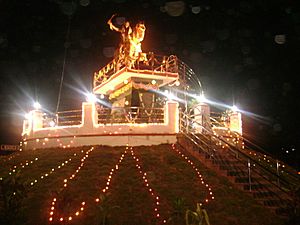Kittur facts for kids
Quick facts for kids
Kittur
|
|
|---|---|
|
Town
|
|
 |
|
| Country | |
| State | Karnataka |
| District | Belagavi |
| Named for | Kittur Chennamma |
| Government | |
| • Body | Town Panchayat |
| Area | |
| • Total | 17.40 km2 (6.72 sq mi) |
| Elevation | 755 m (2,477 ft) |
| Population
(2011)
|
|
| • Total | 16,144 |
| • Density | 927.82/km2 (2,403.0/sq mi) |
| Demonym(s) | Kitturians |
| Language | |
| • Official | Kannada |
| Time zone | UTC+5:30 (IST) |
| PIN |
591115
|
| ISO 3166 code | IN-KA |
| Vehicle registration | KA-24 |
| Nearest city | Dharwad, Belagavi |
| Website | http://www.chennamman-kitturtown.mrc.gov.in/en |
Kittur, also known as Kittoor, is a town in the Belagavi district of Karnataka, India. It is a place with a rich history. Kittur became its own administrative area, called a Taluk, on 23 October 2012. This happened during the Kittur Utsav festival.
Kittur is very important in Indian history. It is known for the brave rebellion led by Kittur Chennamma (1778–1829). She was the Queen (Rani) of Kittur. She fought against the British East India Company, a powerful trading company that also ruled parts of India. During this fight, a British official named St John Thackeray was killed.
In 2011, Kittur was a village within the Sampagaon C D Block.
Contents
A Glimpse into Kittur's Past
Kittur was known by another name, Geejaganahalli, way back in the 12th century. In 1746, the town came under the control of the Maratha Empire. This happened when the Nawab of Savanur handed it over to them.
The Rule of Mallasarja
In 1782, Mallasarja became the ruler of Kittur. He was one of the most powerful leaders the town had. Sadly, his only son passed away before him. When Mallasarja died in 1816, his second wife, Chennamma, took over as the Queen. She is celebrated for her strong fight against the British East India Company.
Rani Chennamma's Brave Fight
The ruins of a palace and a fort can still be seen on the edge of the town. This palace was where Rani Chennamma lived. In the 18th century, Kittur was ruled by the Marathas. After the Third Anglo-Maratha War, the British took control.
In 1824, there was a disagreement about who should rule Kittur next. St John Thackeray, a British Commissioner, was killed in a battle near the Kittur fort. Later, another British army unit attacked Kittur. They captured Queen Chennamma and imprisoned her in Bailhongal Jail, where she later died. Rani Chennamma became a true legend for her courage.
Sangolli Rayanna's Continued Resistance
After Rani Chennamma's death, her general, Sangolli Rayanna, continued the fight. He led several campaigns against the British East India Company. However, he was later captured and executed in 1831. Both Rani Chennamma and Sangolli Rayanna are remembered as heroes who fought for freedom.
Kittur in Literature
The town of Kittur also inspired a fictional coastal town in the 2008 novel Between the Assassinations by Aravind Adiga. It's important to note that the real Belagavi District, where Kittur is located, does not have a coast.



